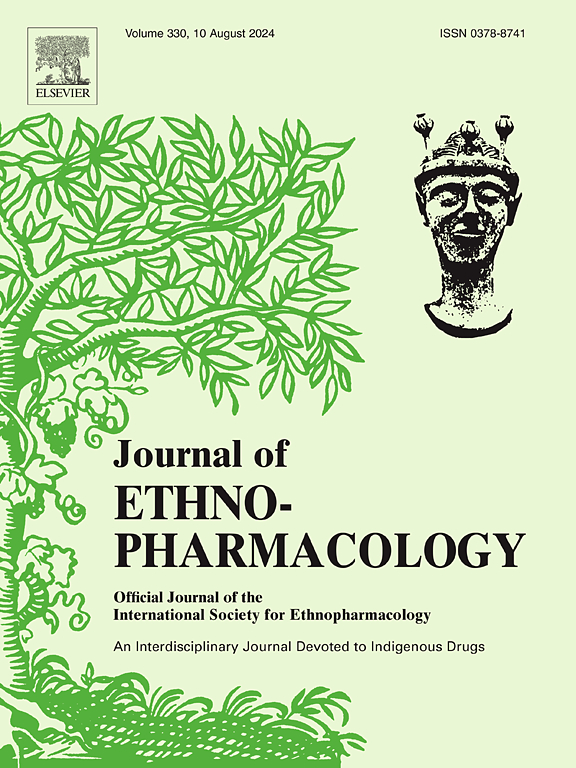Myristica fragrans water extract modulates multiple biological processes to pre-protect anhydrous ethanol-induced gastric ulcers via Akt/JNK/Nrf2 pathway activation
IF 4.8
2区 医学
Q1 CHEMISTRY, MEDICINAL
引用次数: 0
Abstract
Ethnopharmacological relevance
Myristica fragrans (Nutmeg) is a commonly used Chinese herbal medicine and edible spice. According to Pharmacopoeia of People's Republic of China, it has the effects of warming the middle and promoting qi, astringent intestines, and antidiarrheal. In the record of Compendium of Materia Medica, it is the myristica fragrans water extract (MFWE) that is utilized for therapeutic purposes of gastrointestinal disorders frequently.
Research purpose
This study is to investigate the pharmacodynamic material foundation and molecular mechanism of myristica fragrans on gastric ulcers using UHPLC-Q-Orbitrap-MS/MS with network pharmacology and experimental verification. This may provide theoretical guidance for the clinical use of myristica fragrans, and support a theoretical foundation for its future advancement into natural functional products that can relieve acute gastric ulcers.
Materials and methods
Using UHPLC/MS technology and network pharmacology, we identified possible active chemicals molecules, screened out core targets and core pathways, and simulated drug target binding through molecular docking situations. Acute gastric ulcer was caused by intragastric administration of absolute ethanol (0.075 ml/10g). Myristica fragrans water extract (182 mg/kg and 364 mg/kg) was administered orally 14 days in advance. The same method was used to distribute 0.5% carboxymethyl cellulose solution into the Model and Control group. The mice were murdered on the 15th day. Following the sacrifice, the gastric tissue was removed for histological analysis. The tissue needs to detect levels of IL-1β, TNF-α, IL-10, and IL-6 as well as the activity of SOD, GSH-Px, MDA, and MPO. In addition, H&E staining and the TUNEL method were used to observe the effect on the gastric mucosa of mice. Western blot was used to detect apoptosis, ferroptosis, and antioxidation-related proteins.
Results
A total of 10 chemical constituents were identified from MFWE using UHPLC-Q-Orbitrap MS/MS and TCMSP database. Through the network pharmacological analysis of these identified components, it was discovered that the protective effect is mainly carried out by six compounds, they are: Myristicin, Myrisligna, Ferulaldehyde, Dehydrodiisoeugenol, 7-Methoxy-4-methylcoumarin, 1,5-Bis(2,5-dimethoxyphenyl) pentane-1,5-dione. Furthermore, MFWE was found to significantly reduce TNF-α, IL-1β, and IL-6, increase IL-10, and alleviate the inflammation caused by alcoholic gastric ulcers. It can lower MDA and MPO, raise SOD and GSH-Px to relieve oxidative stress. Results from network pharmacology indicated that the Akt, JNK, and apoptosis signaling pathways were essential for the therapeutic effects of MFWE on gastric ulcers. Further literature research revealed that Nrf2 and ferroptosis signaling pathways may be related to the role of MFWE. Molecular biology studies confirmed that MFWE decreased the expression levels of p-Akt/Akt, p-JNK/JNK, Bax, and Keap-1, and increased the expression levels of Bcl-2, Nrf2, HO-1, SLC7A11, GPX4, FTH1.
Conclusion
This study demonstrates that MFWE can alleviate inflammatory responses and diminish both cellular apoptosis and ferroptosis. they confer a protective effect on gastric ulcers via the activation of the Akt/JNK-Keap1-Nrf2-HO-1 signaling pathway and offer a promising therapeutic strategy.

香肉豆蔻水提物通过激活Akt/JNK/Nrf2通路,调节多种生物过程预保护无水乙醇诱导的胃溃疡。
民族药理学相关性:肉豆蔻(Myristica fragrans)是一种常用的中草药和食用香料。根据中华人民共和国药典,它有温中益气,收敛肠道,止泻的作用。在《本草纲目》的记载中,经常用于治疗胃肠道疾病的是肉豆蔻水提物(MFWE)。研究目的:采用UHPLC-Q-Orbitrap-MS/MS结合网络药理学和实验验证,探讨香豆瓣酱对胃溃疡的药理学、物质基础和分子机制。这可能为香豆蔻的临床应用提供理论指导,并为其未来发展为缓解急性胃溃疡的天然功能性产品提供理论基础。材料与方法:利用UHPLC/MS技术和网络药理学,鉴定可能的活性化学分子,筛选核心靶点和核心通路,通过分子对接情况模拟药物靶点结合。无水乙醇(0.075ml/10g)灌胃引起急性胃溃疡。提前14天口服肉豆蔻水提取物(182 mg/kg和364 mg/kg)。模型组和对照组用同样的方法分别给予0.5%羧甲基纤维素溶液。老鼠在第15天被杀死。献祭后,切除胃组织进行组织学分析。组织需要检测IL-1β、TNF-α、IL-10和IL-6的水平,以及SOD、GSH-Px、MDA和MPO的活性。采用H&E染色法和TUNEL法观察其对小鼠胃黏膜的影响。Western blot检测细胞凋亡、铁下垂和抗氧化相关蛋白。结果:利用UHPLC-Q-Orbitrap MS/MS和TCMSP数据库,从MFWE中鉴定出10种化学成分。通过对这些鉴定成分的网络药理分析,发现保护作用主要由6个化合物起作用,它们是:肉豆蔻素、肉豆蔻素、阿魏醛、脱氢二异丁香酚、7-甲氧基-4-甲基香豆素、1,5-双(2,5-二甲氧基苯基)戊烷-1,5-二酮。此外,MFWE还能显著降低TNF-α、IL-1β和IL-6,增加IL-10,减轻酒精性胃溃疡引起的炎症。降低MDA和MPO,升高SOD和GSH-Px,缓解氧化应激。网络药理学结果表明,Akt、JNK和凋亡信号通路在MFWE对胃溃疡的治疗作用中起重要作用。进一步的文献研究发现Nrf2和铁下垂信号通路可能与MFWE的作用有关。分子生物学研究证实,MFWE降低了p-Akt/Akt、p-JNK/JNK、Bax、Keap-1的表达水平,提高了Bcl-2、Nrf2、HO-1、SLC7A11、GPX4、FTH1的表达水平。结论:本研究表明MFWE能减轻炎症反应,减少细胞凋亡和铁下垂。它们通过激活Akt/JNK-Keap1-Nrf2-HO-1信号通路对胃溃疡具有保护作用,并提供了一种有希望的治疗策略。
本文章由计算机程序翻译,如有差异,请以英文原文为准。
求助全文
约1分钟内获得全文
求助全文
来源期刊

Journal of ethnopharmacology
医学-全科医学与补充医学
CiteScore
10.30
自引率
5.60%
发文量
967
审稿时长
77 days
期刊介绍:
The Journal of Ethnopharmacology is dedicated to the exchange of information and understandings about people''s use of plants, fungi, animals, microorganisms and minerals and their biological and pharmacological effects based on the principles established through international conventions. Early people confronted with illness and disease, discovered a wealth of useful therapeutic agents in the plant and animal kingdoms. The empirical knowledge of these medicinal substances and their toxic potential was passed on by oral tradition and sometimes recorded in herbals and other texts on materia medica. Many valuable drugs of today (e.g., atropine, ephedrine, tubocurarine, digoxin, reserpine) came into use through the study of indigenous remedies. Chemists continue to use plant-derived drugs (e.g., morphine, taxol, physostigmine, quinidine, emetine) as prototypes in their attempts to develop more effective and less toxic medicinals.
 求助内容:
求助内容: 应助结果提醒方式:
应助结果提醒方式:


